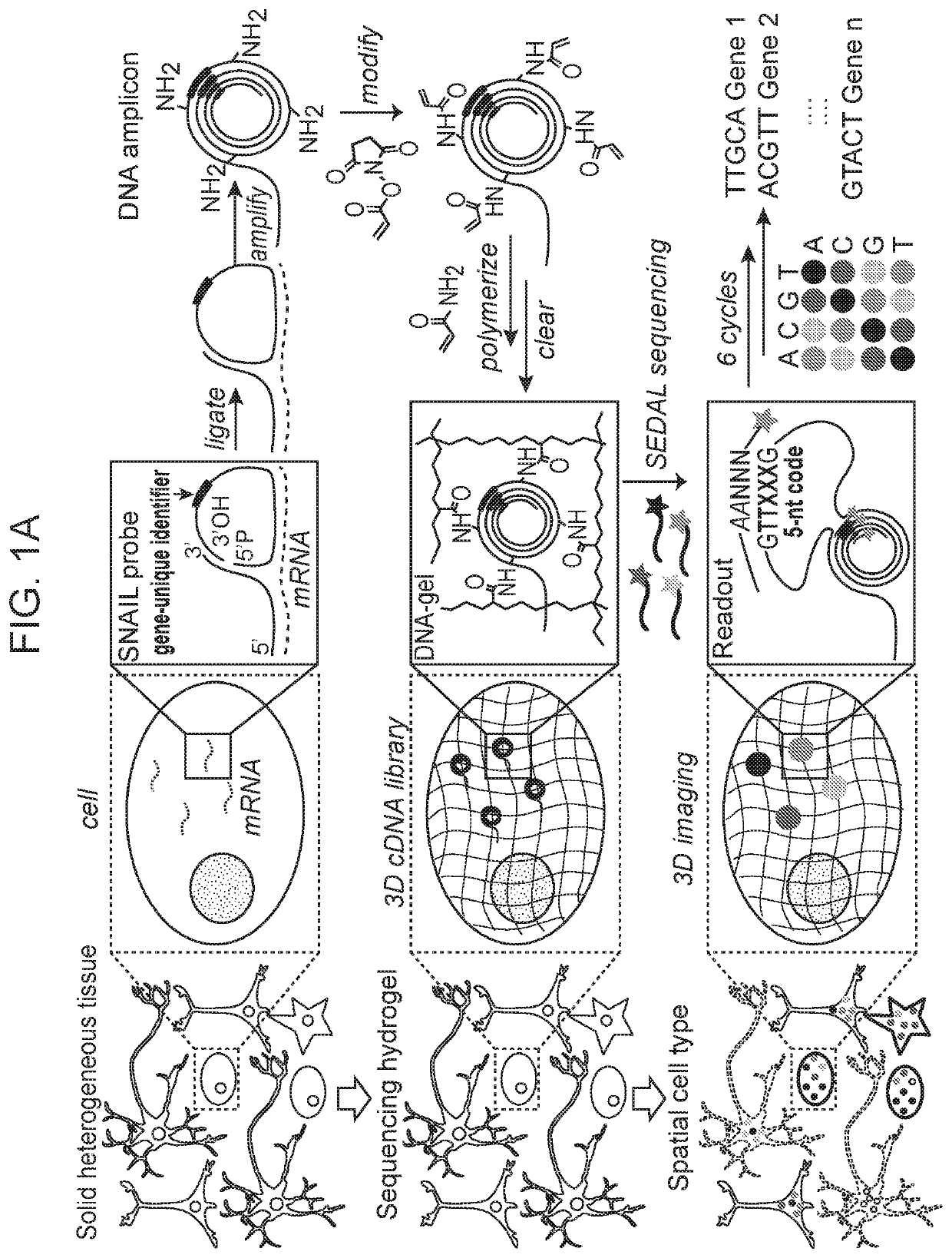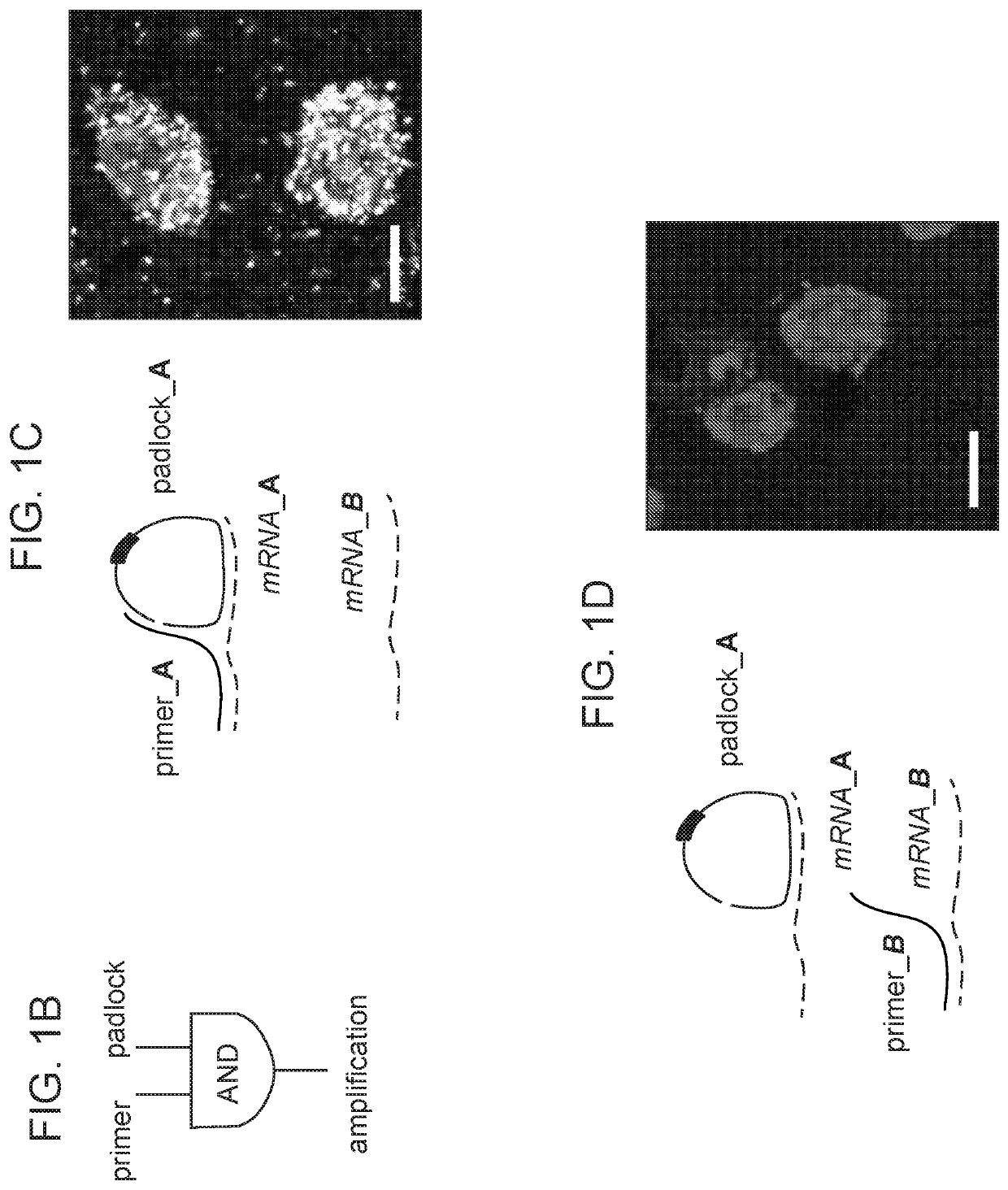Method of in situ gene sequencing
a gene and in situ technology, applied in the field of in situ gene sequencing, can solve the problems of low efficiency, inability to apply current sequencing methods to 3d volumes of intact tissue, and the potential value of such in-tissue sequencing could be enormous
- Summary
- Abstract
- Description
- Claims
- Application Information
AI Technical Summary
Benefits of technology
Problems solved by technology
Method used
Image
Examples
example 1
STARmap
[0299]The methods disclosed herein including the in situ sequencing technology enabled highly-multiplexed gene detection (up to 1000 genes) in intact biological tissue. The methods began with raw biological tissue (fresh or preserved, as little as one-cell or as large as millimeter(s) in size) and resulted in output image-based gene quantification at subcellular and cellular resolution and with high efficiency, low error rate, and fast processing time.
[0300]A schematic diagram of STARmap as described herein was depicted in FIG. 1A. After the brain tissue was prepared (see Methods for mouse brain protocols), the custom SNAIL probes (FIG. 2A) that encountered with and hybridized to intracellular mRNAs (dashed lines) within the intact tissue were enzymatically replicated as cDNA amplicons. The amplicons were constructed in situ with an acrylic acid N-hydroxysuccinimide moiety modification and then copolymerized with acrylamide to embed within a hydrogel network (wavy lines), fol...
example 2
[0302]Reverse transcription may be the major efficiency-limiting step for in situ sequencing, and SNAIL bypassed this step with a pair of primer and padlock probes (FIG. 2A) designed such that only when both probes hybridize to the same RNA molecule. Design of SNAIL probes (one component of STARmap) included the following: each primer or padlock probe (19-25 nucleotides; nt, blue) had a designed Tm (melting temperature of nucleic acids) of 60° C. or higher to hybridize with target RNA, while the complementary sequence between primer and padlock was only 6 nt on each arm with Tm below room temperature, so that primer-padlock DNA-DNA hybridization was negligible during DNA-RNA hybridization at 40° C., but allowed DNA ligation by T4 DNA ligase in the following step.
[0303]The padlock probe was circularized and rolling-circle amplified to generate a cDNA nanoball (amplicon) containing multiple copies of the cDNA (FIG. 1A-1D). This mechanism ensured target-specific signal amplificati...
example 3
cDNA Amplicon Embedding in the Tissue-Hydrogel Setting
[0304]To enable cDNA amplicon embedding in the tissue-hydrogel setting, amine-modified nucleotides were spiked into the rolling circle amplification reaction, functionalized with an acrylamide moiety using acrylic acid N-hydroxysuccinimide esters, and copolymerized with acrylamide monomers to form a hydrogel (FIG. 1A, FIG. 3A). A schematic diagram of hydrogel-tissue chemistry for STARmap in thin tissue slices was depicted in FIG. 3A. DNA amplicons were synthesized in the presence of minor levels of 5-(3-aminoallyl)-dUTP, which replaced T at a low rate and allowed further functionalization with the polymerizable acrylamide moiety using acrylic acid N-hydroxysuccinimide ester (AA-NHS), so that the DNA amplicons were covalently anchored within the polyacrylamide network at multiple sites (FIG. 3A, right). The resulting tissue-hydrogel was then subjected to protein digestion and lipid removal to enhance transparency (FIG. 3B-3E). Flu...
PUM
| Property | Measurement | Unit |
|---|---|---|
| thickness | aaaaa | aaaaa |
| thickness | aaaaa | aaaaa |
| temperature | aaaaa | aaaaa |
Abstract
Description
Claims
Application Information
 Login to View More
Login to View More - R&D
- Intellectual Property
- Life Sciences
- Materials
- Tech Scout
- Unparalleled Data Quality
- Higher Quality Content
- 60% Fewer Hallucinations
Browse by: Latest US Patents, China's latest patents, Technical Efficacy Thesaurus, Application Domain, Technology Topic, Popular Technical Reports.
© 2025 PatSnap. All rights reserved.Legal|Privacy policy|Modern Slavery Act Transparency Statement|Sitemap|About US| Contact US: help@patsnap.com



